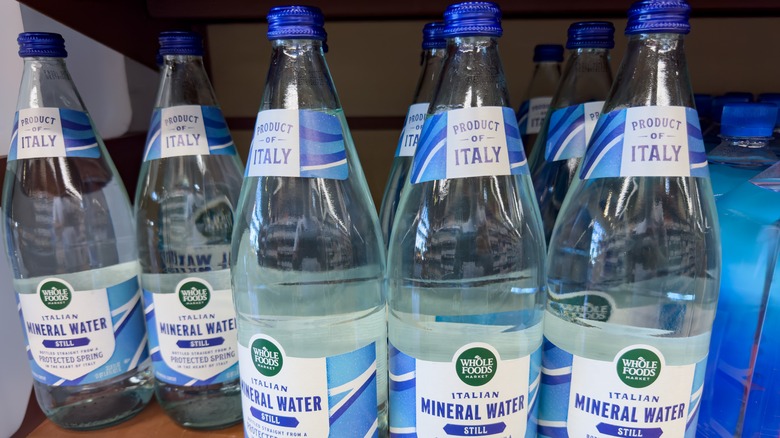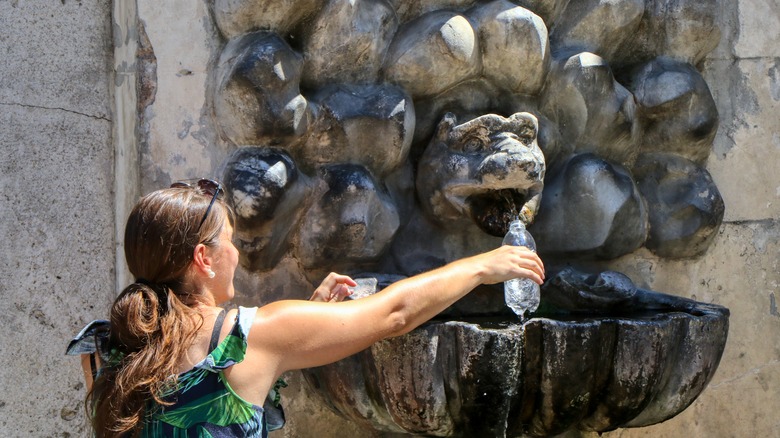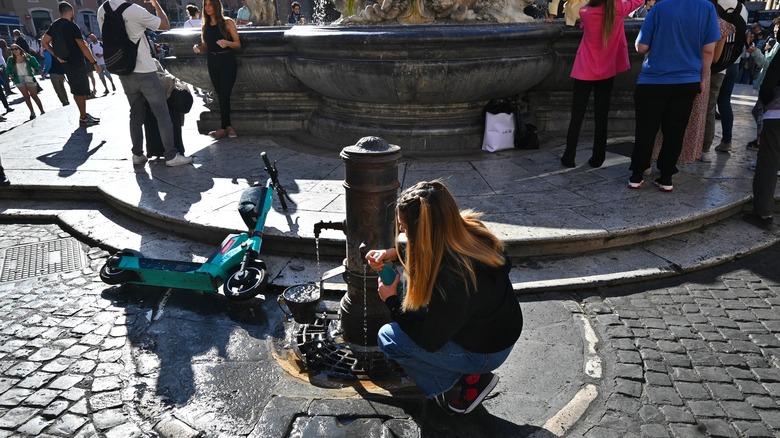Why Buying Bottled Water As A Tourist In Italy Is A Big Mistake
As a tourist in Italy, you'd expect to spend your money on delectable street eats and iconic dishes from one of the world's most recognizable cuisines. What you don't want to do is spend a good chunk of change on water. Fortunately, Italy has a unique feature that can help you save most if not all of those small bills and use them instead to pay in cash at Italian restaurants, which is often preferred. Abundant, safe, and free hydration is a matter of historical pride for the country, especially its capital, Rome. The way this water is delivered every day to thousands of thirsty locals, tourists, and even pets, is through the country's vast network of le fontanelle or little fountains and the more recognizable nasoni (singular: nasone) which literally translates to "big nose" because of how they look.
Rome alone has over 2000 such drinking fountains scattered around the city, many of them over a century old. In addition to being a part of the city's iconic history of hydro-engineering which includes its ancient aqueduct system, these fountains continue to provide free and clean drinking water. Walk around Rome's city center and you will be within reach of over 200 nasoni as well as dozens of artistic fountains that spout potable water. There are also apps that let you find the closest ones to you. And while Rome's drinking fountains get a lot of publicity, they are actually present all across Italy.
Drinking fountains, or nasoni, are entrenched in Italy's history
While Rome's aqueduct system dates back to 300 B.C., a large section of it was destroyed during the subsequent fall of the Roman empire and rebuilt in the 17th and 18th centuries. Construction on the nasoni started in the 1870s when running water wasn't a common feature in most homes and the city suffered from water-borne disease outbreaks. Thus, clean drinking water became a priority for the city, and you can still see S.P.Q.R (Senatus Populous Romanus or Senate and People of Rome), stamped on most nasoni. The fountains also became the water coolers of their time as a meeting point for people.
Regular nasoni are easy enough to spot as they are cylindrical and made of cast iron. However, ornate examples, including ones made of marble, exist around the Italian capital. Some early nasoni are even in the shape of a dragon or wolf's head, the latter an homage to the city's mythical she-wolf who suckled Rome's founders Romulus and Remus. However, considering the city is dotted with historical fountains, it's a good idea to check if it's meant for drinking before using it. Rome's famous Trevi fountain was originally a drinking fountain but not anymore. In short, while you may get strange looks for drinking cappuccino at the wrong time of day in Italy, you won't be judged for drinking water or filling your bottle from a dragon-headed fountain (unless you're not meant to drink from it).
Nasoni are safe, but you can also find cheap bottled water in Italy
People may suggest you only drink bottled water when you travel, and for the most part, that is sage advice. However, it may be worthwhile to make an exception in Italy provided your immunity is not compromised by any preexisting health considerations. Nasoni deploy the same water that is piped into Italian households, making it safe to drink. The constant flow of water also ensures that bacteria doesn't build up in the drinking fountains. Most nasoni feature a long spout, which is where their "big nose" moniker comes from. Often the spout will also have an additional hole on top. Blocking the main water outlet redirects water to the hole on top, making it easier to drink from the nasoni. And, of course, you can always use it to fill your water bottles whenever you're out and about in Rome.
Despite all the historical significance and local pride associated with Italy's drinking fountains, keep in mind that you are not confined to them. If you don't want to drink tap water or pay for expensive bottles when eating out since restaurants in Europe often charge for water, head to the local supermarkets. You can often find bottled water at a much lower price than what you'd pay stateside. On average, mineral water costs 20 Euro cents (about $0.22) per liter in Italy. Keep an eye out for discounts and you may find it for even cheaper.


